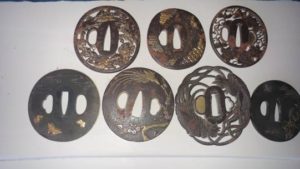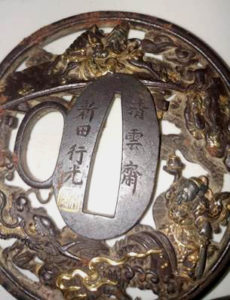 What are these “little disks?” wrote VA, a reader all the way from South Africa. She said her Uncle collected these odd tiddlywinks. She has no idea where he got them or what anybody used them for, nor does she know their age. They look like coins, tokens, or medals. They range between 60 mm and 80 mm. She doesn’t know if they are valuable or just toys.
What are these “little disks?” wrote VA, a reader all the way from South Africa. She said her Uncle collected these odd tiddlywinks. She has no idea where he got them or what anybody used them for, nor does she know their age. They look like coins, tokens, or medals. They range between 60 mm and 80 mm. She doesn’t know if they are valuable or just toys.
VA, they are old, unique, and perhaps very valuable. When I say old, maybe as old as the 12th century. When I say unique, they hail from a cultural period and a style of feudal life that we will never experience. When I say valuable, a nice old one might bring thousands of dollars. So no, they are not coins or toys.
Japanese Tsuba
Tsuba came as part and parcel of a lovely antique Japanese sword. Because of their individual uniqueness people collect them as art today. I love Japanese art in general because the simplest surface can be a work of art that carries symbolic cultural meaning. Often I see small Japanese sculptures with an intricately carved foot or base, although never seen when the sculpture is displayed. The aesthetic expands to the unseen and expands beyond the utilitarian. These tsuba echo that aesthetic.
I find the story fascinating. Each of these individual elements of a sword are, as an object class, unique in the history of weaponry because we considered them independent works of art. Yet they’re also completely indispensable to both the sword and to the art of battle. Tsuba fit the Uchigatana sword between the sword and the hilt grip, protecting the hand that holds the grip from sliding onto the blade in a thrust. I experienced the great fortune to appraise a Santa Barbara collection of these recently, all off the sword.
Tsuba Symbolism
Decoration sometimes appears naturalistic, organic in theme, perhaps religious symbolism, or stories from myth. Each one conveys a symbolic power to the warrior. They portray auspicious symbols, as well as epitomize, in the narrative of the image portrayed, respect for tradition and order, so necessary to the honorable field of battle for centuries in Japan.
Made primarily from iron, they’re often overlaid with silver or gold, brass, cloisonné, copper, or a mixture of gold and copper, which shows in a black patina. Specific experts in the forging of tsuba, men who for generations created only these ‘disks,’ make many of the best. Samurai sought out these great makers.
More than a good luck piece
 Tsuba also guard the warrior’s hand, thus they’re usually round or ovoid. In early centuries the larger sized tsuba worked efficiently to block a parried thrust from an opponent. The first tsuba were crafted in the 12th century. Yet in times when peace flourished in Japan, they became highly decorated. Ancient Samurai families emblazoned tsuba with their family crests.
Tsuba also guard the warrior’s hand, thus they’re usually round or ovoid. In early centuries the larger sized tsuba worked efficiently to block a parried thrust from an opponent. The first tsuba were crafted in the 12th century. Yet in times when peace flourished in Japan, they became highly decorated. Ancient Samurai families emblazoned tsuba with their family crests.
A master of the tsuba forged a finely proportioned and weighted disk to bring balance and weight to the sword. The imagery protected the warrior in symbolic ways, with a visual meaning, but the tsuba protected in practical ways. A Samurai knight wore the Uchigatana sword directly in his belt. So such a protuberance like the tsuba helped him to locate the blade in the scabbard, acting as a guide to the hand when the warrior was mounted in battle.
Themes
One might perceive the themes portrayed on these beauties as deceivingly simple, almost architectural. Yet I’ve seen themes such as landscapes, castles, bridges, wild flowers, elephants, and monkeys, as well as simple I Ching hash marks.
Interestingly we mainly find Tsuba in uniform sizes because in the 17th century the Shogunate laid down laws of size restrictions, called The Laws for Military Houses. This became necessary because the larger the tsuba, the more leverage a warrior has against an opponent. Traditionally to start a duel between two warriors they pushed hard against the tsuba(s). In a duel two warriors locked tsuba(s) together and leaned in to force one off balance and to gain the first strike, and upper hand. So size became standardized after the 17th century to keep odds even.
VA, your tsuba are all from the later Edo period, yet some bear exquisite metalwork. I believe just one might bring $800. So no, they’re not tiddlywinks. Regards from Santa Barbara!
So very interesting!!!
Hello How do you do ? I found this information to be very helpful . I have a tsuba I would like to have appraised .Do you do that ? Thank you , Lance
If you want to submit an object for a possible article please email photos to elizabethappraisals@gmail.com
Hello How do you do ? I found this information to be very helpful . I have a tsuba I would like to have appraised .Do you do that ? Thank you , Lance